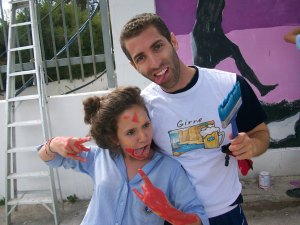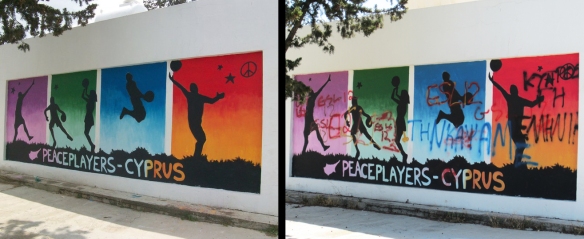In Cyprus, there are plenty of picturesque beaches, rolling wheat fields, ancient ruins, and smoking tavernas. But one thing Cyprus is lacking is public art. This is why early on in my 2-year contract with PeacePlayers International I proposed organizing a mural project at one of the schools where we worked. PeacePlayers International, a D.C. based organization that uses basketball to bring together children from divided communities around the world, began working in Cyprus in 2007 to help reduce tensions and bridge the gap between the country’s Greek-Cypriot and Turkish-Cypriot youth. In 1974, a Greek military coup and a subsequent invasion by Turkey separated the island and its two major ethnic groups, Greek-Cypriots and Turkish-Cypriots. Today, Cyprus remains partitioned by an UN-patrolled buffer zone, with Greek-Cypriots concentrated in the south and Turkish-Cypriots in the north. Only since 2003 were limited crossings allowed between the two groups.
The first mural was to be done at Agios Antonios Elementary, a school that provides special assistance to kids in underprivileged areas. Agios Antonios is just one of 10 schools in the entire island where children of both Greek-Cypriot and Turkish-Cypriot descent can still attend classes together. I had anticipated some excitement, but the children’s intense desire to help was overwhelming, and before I knew it the mural was complete. The finished product was more than just something nice to look at; it was something the kids cold see everyday and be proud of, showing the world just how much potential they have if given an opportunity.
After a lot of positive feedback from the school and parents, we decided to do one more at another bicommunal school, the English School of Nicosia. Like Agios Antonios, the English School is located on the southern, Greek-Cypriot side of the island, but many Turkish-Cypriots take buses from the north (some from villages over an hour away) to attend the school. Founded in 1900, the school was always a place where pupils from all backgrounds and religions could study together. However since the conflict of 1974, the school operated with only Greek-Cypriots, but in 2003, when the first border crossing was allowed after 29 years, the English School readmitted Turkish-Cypriot students.
A large blank wall near the school entrance was the perfect location for a colorful painting. It was again great to see the children pick up the brushes and begin splattering different colors on the wall. For some of the kids, this was their first opportunity to paint, and I was delighted to see their enthusiasm to try something new. I greatly enjoyed showing them how to blend colors by mixing the wet paint and going back and forth over and over again until the transitions became smooth. With all the kids running around hastily dipping brushes in cans of paint, it was hard to remember that these were Turkish-Cypriot and Greek-Cypriot children that lived on opposite sides of a generation long conflict. From now on the kids will have a bright picture to welcome them to school everyday. Or so I thought…
Exactly one year after we finished painting, I got a Facebook message from one of my kids, “Did you see what they’ve done to the mural in our school? :/” I returned the following week to see the mural had been graffitied over in dramatic fashion. After staring at the destruction for a little while, one thing stood out to me: the surrounding walls remained pristine white. Whoever did this was trying to send a message to the mural painters. While standing in front of the once beautiful mural, Fuat, the 14-year-old Turkish-Cypriot who had messaged me, walked by and asked if I understood what it said. There was no doubt about it, the large Greek letters spelled out the words: “Cyprus is Greek” and “It will burn.”
As I drove away from the school I thought about little Fuat, and I got more and more frustrated. I wasn’t just angry with the hooligan children who had painted over the mural, I was mad at the school’s administration for letting such hateful messages be prominently posted at the entrance of the school for over a month. After all it’s the school’s responsibility to protect their students from this type of hate speech. But when I later complained to some local parents, I couldn’t believe what I heard. One Turkish-Cypriot mom told me that she wasn’t surprised at all, that the ethnically driven hatred was starting from the top of the school, including the administration, the teachers and even the parents association which as it turns out doesn’t have a single Turkish-Cypriot member. She told me that despite the school being bicommunal, often kids end up leaving more nationalistic then when they started, and even though the English School is internationally recognized as a good academic institution, she would never send her children there.
I was shocked. Even after leading bicommunal basketball practices at the school for 2 years, I had no idea it was this bad. But despite my sad feelings, I couldn’t let my last mural in Cyprus go down like that. With two weeks to go in my contract, I headed down to Kolosi, a Greek-Cypriot elementary school on the southern coast, and with the help of nearly 60 little kids, I painted an exact copy of the mural from the English School. As a mob of happy paintbrush wielding children ran around in circles, I was again reminded of the power of social development, whether basketball or painting, to bring children together. There will always be those that try to stand in our way, but as long as there are more kids and more paint, we can continue to send out our message of peace.






